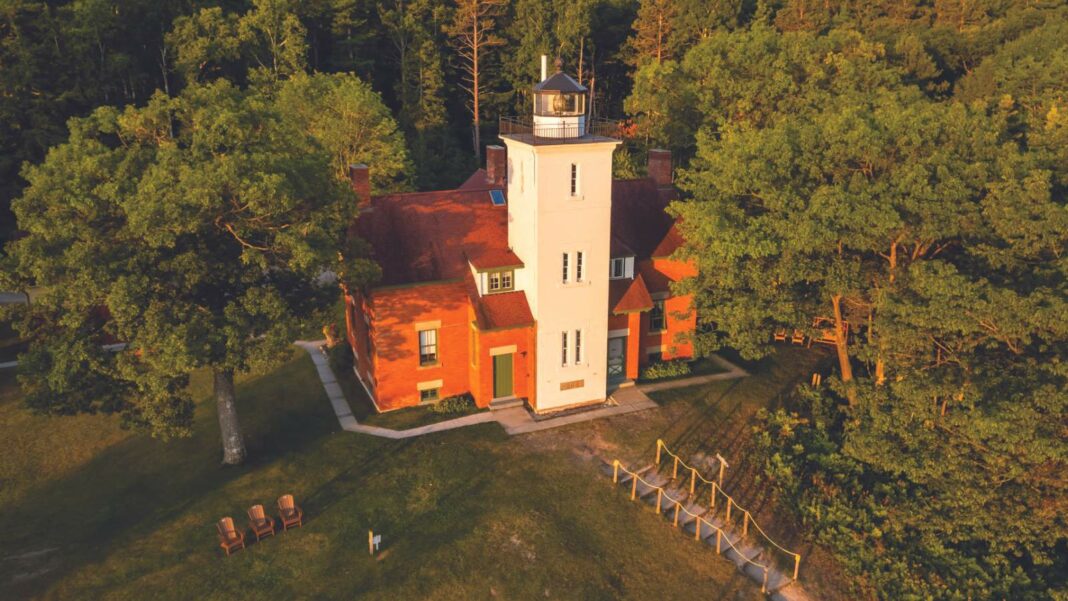By Yvette Pecha
There is perhaps no structure as universally adored as the lighthouse. Whatever the reason—be it their place in history, their iconic architecture, or the fact that they embody safety and strength—these landmarks tend to inspire and intrigue us.
In Michigan, we are lucky enough to have more lighthouses than any other state, many of which can be found right here in the PIE&G service area. One of them is the 40 Mile Point Lighthouse near Rogers City. It was built in 1896 and was an important piece of the Great Lakes shipping industry, but over time, as often happens with lighthouses, it began to fall into disarray. In 1996, the lighthouse was assigned for disposal. That’s when Presque Isle County, which already deeded the surrounding property, applied to also have jurisdiction of the lighthouse. That request was granted in 1998, and since then, county officials have been working alongside the 40 Mile Point Lighthouse Society to restore the entire light station.
Pat Williams is the vice president of the society, with which he and his wife Shawn have been involved for many years. As a child, Shawn spent summers vacationing with her family in a cottage a half mile from the lighthouse. It made a lasting impression on her, and when she and Pat retired, they moved into the cottage and renovated it into a house.
“When we moved here, we already loved the lighthouse and would visit often,” Pat said. “So people in the society said, ‘oh, maybe you could come and volunteer,’ and that just naturally progressed into us having more and more to do with it.” The Williamses, PIE&G members, have pitched in just about every regard, but these days, Pat mostly handles the website and is about to take over the Guest Keepers program. Shawn (the society’s secretary) runs the gift shop, which Pat says is one of the busiest volunteer jobs. “Admission to the park is free, so the gift shop is our means of defraying the cost of keeping the lighthouse open,” he said.
The grounds of the lighthouse tower are comprised of just under 40 acres that also house the gift shop, the old Glawe one-room schoolhouse, a fog signal building, and a pilot house. Additionally, there are several hiking trails, a campground, a chicken coop, and the park’s large, shallow beach, where visitors can swim, kayak, or paddleboard. The beach offers a view of the wreckage of the Joseph S. Fay, a schooner that ran aground in 1905 during a snowstorm. Part of the ship is on the beach itself, while part of it can be seen by divers and snorkelers under about 15 feet of water.
The lighthouse tower is a duplex building with a museum on one side of it and living quarters for the groundskeeper’s family on the other. Pat says much of what you see in the lighthouse is original, including white ash floors and woodwork. He says it’s been fully kept in the style of the 1920s and ‘30s. “The furnishings are period-correct,” he said. “You’ll see the sewing machines and looms reminiscent of what keepers would work with in that day.”
Pat says that while visitors really enjoy seeing what lighthouse life used to look like, they are allowed to do more than look. “We’re a bit unique in that if someone wants to touch the tableware or open a door, we don’t discourage it. It’s not the type of place where everything is behind glass or roped off. We want them to look at something up close and ask, ’What was this for?’”
One notable exception to this carefree approach is in the tower of the lighthouse. “The county owns the lighthouse, but the Coast Guard owns the light itself,” Pat said. “They want to keep people from touching the lens, so there is always a docent present.” The lens is an important part of the light station’s history. Only the second lens to have been used since the tower’s inception, it is also the last working fourth-order Fresnel lens on Lake Huron.
In addition to all of the things guests can enjoy, Pat says the appeal of the park is in large part due simply to where it’s located. “There are so many people along the lakes, certainly in Rogers City, invested in freighters and the whole shipping community,” Pat said. “People are fascinated with how they were able to ship all of these products on the lake for so long and maintain the business safely. In large part, it’s because of lighthouses.”
The society can always use more volunteers in the following areas:
- Restoration projects – Sanding, scraping, painting,carpentry, etc.
- Serving as a docent (giving tours)
- Cleaning trails, raking leaves, grounds maintenance
- Clerical work
- Guest Lighthouse Keepers program – Volunteers bring their own RV to the onsite campground and work and live at the lighthouse for free in two- to four-week increments.
Visit fortymilepointlighthouse.org to learn more!






